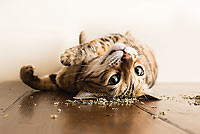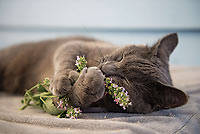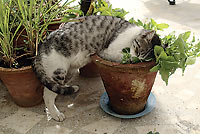Believe it or not, scientists have yet to discover why catnip drives kitties wild. They’ve identified the chemical substance in catnip that causes the effect – it’s called nepetalactone, an organic compound. But we still don’t know why it works. We just know that when it works, it REALLY works!
Behaviors people have witnessed after offering catnip to their pet include nosing, chewing, and batting the catnip container while drooling buckets; shaking their heads; rolling around and rubbing their bodies on the floor; losing their balance, falling and stumbling around; repetitively kicking their hind legs; and showing excitement and chasing behavior.
Catnip plants (Nepeta cataria and other Nepeta species) are members of the mint family and contain volatile oils, sterols, acids and tannins. Native to Europe, Asia and Africa, the plant was brought to North America by settlers; nowadays, the plant is popular in herb gardens and grows widely as a weed. Catnip is considered to be nonaddictive and completely harmless to cats.
Catnip Affects Areas of the Feline Brain Related to Hunger, Predatory and Sexual Behavior
The School of Behavioral Studies at Tufts offers a few possible explanations for feline behavior while under the influence of catnip. Some of the behaviors are playful in nature, catnip puts kitties in the mood to have fun.
Chewing and drooling seem to be associated with getting food, while rolling and rubbing appear to be sexual behaviors. Tandem hind leg kicking could be a predatory behavior, as is chasing.
It seems catnip may inspire bursts of expression of several natural feline behaviors, almost as if the kitty has let go of his inhibitions. (How many of us are more willing to hit the dance floor after a pre-boogie cocktail or two?)
According to Tufts, “This implies a general excitatory effect on areas of the brain, particularly those centered in and around the hypothalamus, the region that controls appetitive, predatory and sexual behavior.”
Human brains are physiologically different from cat brains and people do not react to catnip by getting “high.” Native Americans, however, once used catnip for the uncontrollable cries of infant colic. It also serves as a mild sedative in some herbal teas. In alternative medicine circles, catnip is commonly recommended by herbalists to lessen migraine headaches and to relieve cramps, gas, indigestion, insomnia, nervousness and anorexia, or as an herbal paste to reduce swelling associated with arthritis and soft tissue injury.
While many cats can’t get enough of catnip, others ignore it completely. Whether or not your kitty likes to indulge all comes down to genetics. “The catnip response is actually inherited as an autosomal dominant trait,” from the American Association of Feline Practitioners. “Therefore, it’s inherited from a cat’s parents—if both parents don’t respond, neither will their offspring.”
Mosquitos and other Creepies don’t understand all the Fuss
While cats go wild for nepetalactone, mosquitos have the opposite reaction. After discovering that catnip was better at repelling the dreaded suckers than DEET, researchers at Rutgers University created a highly concentrated super-breed for the insect repellent industry. Other pests that turn their noses up at catnip include cockroaches, flies, dust mites, termites, and deer ticks. Planting this in your garden will not only keep a fresh supply of fresh nip for your feline friends; it keeps pests away. Just beware that you keep this mint relative contained with barriers. It does not understand the meaning of personal space and will take over anything planted next to it.
Catnip May Help Improve the Relationship Between Feuding Felines
Recent research suggests that not only does the nepetalactone molecule have an opioid shape, it also has an opium-like action, meaning it stimulates opioid receptors in the brain in the same way morphine does. Dr. Dodman believes the reason a benign herb like catnip contains such a powerful substance may be to attract insects that will subsequently assist in cross-pollination and other activities beneficial to plants.
When a susceptible kitty gets hold of catnip and absorbs the nepetalactone, her pleasure centers (opioid receptors) in the brain are activated and the next thing you know, she’s rolling around in a state of goofy bliss.
Despite the fact that catnip appears to make susceptible kitties “high,” it is an entirely harmless and non-addictive herb. It may even help in certain situations, for example, with battling cats. Kitties who don’t get along may see their nemesis in a new and friendlier light while under the influence of catnip – and the truce has been known to hold after the effects of the nepetalactone wear off.
In addition, catnip has pain-relieving properties that may be helpful for some kitties, similar to the effects of marijuana in some people.
Catnip Is Good, Safe Fun
Fear not—this is one herb that doctors agree is perfectly fine to indulge in from time to time. The only time a pet parent should stay away from catnip is when their kitty has feline asthma, since the small particles can exacerbate coughing and wheezing if inhaled.
There are certainly benefits to occasionally giving your cat catnip, including the environmental stimulation that the catnip provides. There are no known negatives—other than the cleanup that can result from some cats who are very exuberant with their catnip play!
Dog-Friendly Walks/Hikes
in the Moab Area |
Corona Arch - Easy/Moderate. 1.3 Miles one way. Trailhead is 25 minute drive from Moab. North on US-191 to Potash Road (Utah 279).
Mill Creek Pathway - Easy. 1.1 Miles. Little to no driving. Starts at the intersection of 100 South and 100 West, a block off of Main Street.
Portal Overlook - Hard. 2.0 Miles one way. Trailhead is 20 minute drive from Moab. N. on US-191 to Potash Road (Utah 279).
Grandstaff Canyon - Moderate. 2.0 Miles one way. Trailhead is 10-minute drive from Moab. North on US-191 to the River Road (Utah 128) |
|